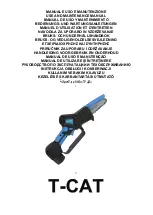
9
FUNCTIONAL DESCRIPTION
CAUTION:
•
Always be sure that the tool is switched off and
unplugged before adjusting or checking function
on the tool.
Adjusting the depth of cut
Fig.7
The depth of cut may be adjusted by turning the handle.
Turn the handle counterclockwise to raise the blade or
clockwise to lower it.
NOTE:
•
Use a shallow depth setting when cutting thin
materials in order to obtain a cleaner cut.
Adjusting the bevel angle
Fig.8
Loosen the lock knob counterclockwise and the desired
angle (0° - 45°) is obtained. The arrow pointer indicates
the bevel angle.
After obtaining the desired angle, tighten the lock knob
clockwise to secure the adjustment.
CAUTION:
•
After adjusting the bevel angle, be sure to tighten
the lock knob securely.
Switch action
CAUTION:
•
Remove workpiece from the table.
•
Before plugging in the tool, always be sure that the
tool is switched off.
Fig.9
To start the tool, press the ON ( I ) button.
To stop it, press the OFF ( O ) button or the switch cover.
ASSEMBLY
CAUTION:
•
Always be sure that the tool is switched off and
unplugged before carrying out any work on the tool.
The tool is shipped from the factory with the saw blade
and blade guard not in the installed condition.
Removing or installing saw blade
CAUTION:
•
Always be sure that the tool is switched off and
unplugged before installing or removing the blade.
•
Use only the Makita hex wrench provided to install
or remove the blade. Failure to do so may result in
overtightening or insufficient tightening of the hex
bolt. This could cause an injury.
•
Use the following saw blade. Do not use saw
blades which do not comply with the
characteristics specified in these instructions.
Model
Dia.
Blade thickness
Kerf
2712
315 mm
2 mm or less
2.8 mm or more
014540
Fig.10
To remove the saw blade, remove the table insert on the
table. Hold the outer flange with the wrench and loosen
the hex bolt clockwise with the hex wrench. Then
remove the outer flange.
Fig.11
To install the saw blade, assemble the inner flange, saw
blade, outer flange, washer and hex bolt onto the arbor.
Make sure that the teeth of the blade are pointing down
at the front of the table.
CAUTION:
•
Keep the flange surface clean of dirt or other
adhering matter; it could cause blade slippage. Be
sure that the blade is installed so that the teeth are
aligned in the cutting (turning) direction.
To secure the blade in place, hold the outer flange with
the wrench, then tighten the hex bolt counterclockwise
with the hex wrench. BE SURE TO TIGHTEN THE HEX
BOLT SECURELY.
Fig.12
CAUTION:
•
Be sure to hold the hex bolt carefully with the hex
wrench. If your grip should slip, the hex wrench
may come off the hex bolt, and your hand could
strike the sharp blade edges.
Installing blade guard
CAUTION:
•
Before installing the blade guard, adjust the depth
of cut to its maximum elevation.
Fig.13
Fig.14
Place the blade guard into the groove on the riving knife.
Secure the blade guard by pivoting the lever on the
blade guard.
CAUTION:
•
If the blade and riving knife are not aligned properly,
a dangerous pinching condition may result during
operation. Make sure they are properly aligned. You
could suffer serious personal injury while using the
tool without a properly aligned riving knife.
•
If they are not aligned for any reasons, always
have Makita authorized service center repair it.
•
Don't remove the riving knife.
Fig.15
There must be a clearance of about 4 - 5 mm between
the riving knife and the blade teeth. Adjust the riving
knife accordingly and tighten the hex nut securely.










































